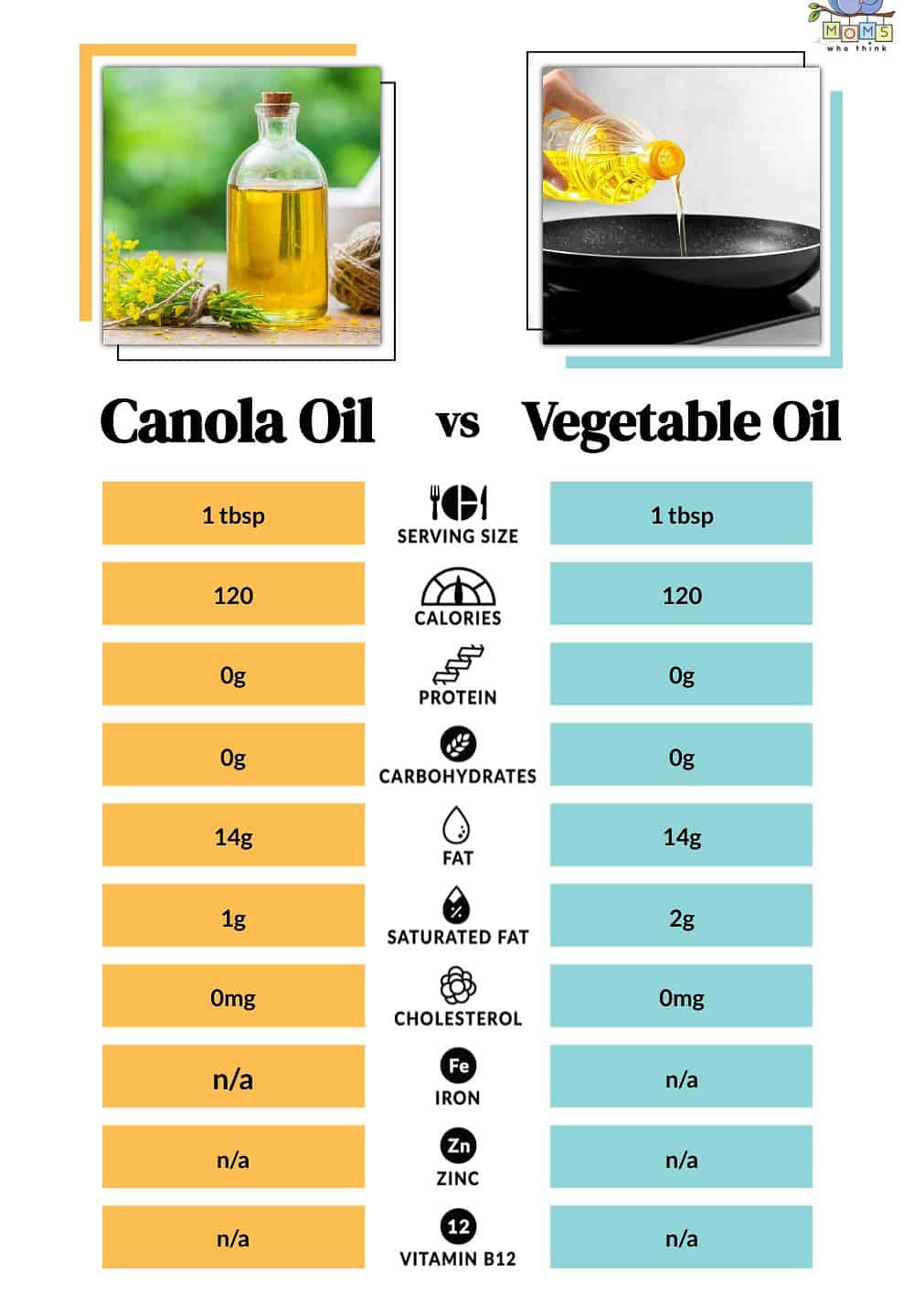Nutritional Comparison Of Soybean And Canola Oil

Soybean oil and canola oil have significant differences in their nutritional profiles. While soybean oil is higher in polyunsaturated fats, particularly omega-6 fatty acids, canola oil has a favorable balance of monounsaturated and polyunsaturated fats, including omega-6 and omega-3 fatty acids. Canola oil also has a lower saturated fat content compared to soybean oil. Additionally, soybean oil contains vitamins E and K, while both oils are highly refined. It is important to consider these nutritional differences when choosing between soybean oil and canola oil for cooking and consumption.
Nutritional Content Of Soybean Oil
Soybean oil is rich in polyunsaturated fats, particularly omega-6 fatty acids. It also contains vitamins E and K. However, soybean oil is high in omega-6 fatty acids, which can contribute to inflammation when consumed in excess. Additionally, soybean oil is highly refined, which may impact its nutritional value. It is important to note that while soybean oil does have some nutritional benefits, it should be consumed in moderation to maintain a healthy balance of omega-6 and omega-3 fatty acids in the diet.
Nutritional Content Of Canola Oil
Canola oil is known for its rich nutritional profile. It is low in saturated fat and contains a good balance of omega-3 and omega-6 fatty acids. It also provides high amounts of monounsaturated fats, which are beneficial for heart health. Canola oil is a good source of vitamin E, an antioxidant that helps protect the body’s cells from damage. Additionally, it contains phytosterols, which can help lower cholesterol levels. With its nutritional composition, canola oil is a healthy option for cooking and baking.
Health Benefits Of Soybean And Canola Oil

Soybean oil offers several health benefits. It is rich in unsaturated fats, including omega-3 fatty acids, which have been shown to have anti-inflammatory effects and promote heart health. Soybean oil also contains vitamin E, an antioxidant that helps protect the body’s cells from damage. Additionally, it may help lower LDL cholesterol levels and reduce the risk of cardiovascular diseases. Canola oil, on the other hand, is known for its high content of monounsaturated fats, which can help lower bad cholesterol levels and reduce the risk of heart disease. Its omega-3 fatty acids also contribute to heart health. Both oils are good sources of energy and essential fatty acids.
Health Benefits Of Consuming Soybean Oil
Consuming soybean oil provides several health benefits. It is rich in unsaturated fats, including omega-3 fatty acids, which have been shown to have anti-inflammatory effects and promote heart health. The vitamin E present in soybean oil acts as an antioxidant, protecting the body’s cells from damage. Additionally, soybean oil may help lower LDL cholesterol levels and reduce the risk of cardiovascular diseases. Its energy content and essential fatty acids make it a valuable addition to a balanced diet. Incorporating soybean oil into cooking and meals can contribute to overall health and well-being.
Health Benefits Of Consuming Canola Oil
Consuming Canola oil provides several health benefits. It is rich in monounsaturated fats, which have been shown to lower LDL cholesterol levels and reduce the risk of heart diseases. Canola oil also contains omega-3 fatty acids, which have anti-inflammatory properties and promote brain health. Additionally, it is a good source of vitamin E, which acts as an antioxidant and protects the body’s cells from damage. Incorporating Canola oil into cooking and meals can contribute to a healthy diet and overall well-being.
Cooking Properties And Smoke Point

Canola oil is known for its versatility in cooking, as it has a high smoke point of 400°F (204°C), making it suitable for a wide range of cooking methods including frying, sautéing, and baking. It has a neutral flavor that doesn’t overpower the taste of other ingredients, making it a popular choice for both savory and sweet dishes. Furthermore, canola oil has a light texture that allows it to evenly coat ingredients and promote even cooking. Its cooking properties make it a reliable and versatile choice for various culinary applications.
Cooking Properties Of Soybean Oil
Soybean oil is known for its high smoke point, which makes it suitable for various cooking methods. With a smoke point of up to 475°F (246°C), soybean oil can be used for frying, sautéing, grilling, and even deep frying. Its mild flavor allows it to enhance the taste of dishes without overpowering other ingredients. Soybean oil is commonly used in Asian-inspired dishes like stir-fries and fried rice due to its ability to withstand high heat. Its versatility and high smoke point make it a reliable choice for cooking a wide range of recipes.
Cooking Properties Of Canola Oil
Canola oil is known for its versatility in the kitchen, making it a popular choice for cooking. With a lower smoke point compared to soybean oil, ranging from 225°F to 445°F (107°C to 230°C), canola oil is best suited for low to medium heat cooking methods such as sautéing and baking. It can also be used for salad dressings and marinades, thanks to its mild and neutral flavor. Canola oil has a light texture and a high smoke point, making it a reliable option for a variety of recipes.
Flavor Profile And Usage

Canola oil has a mild and neutral flavor, making it a versatile oil that can be used in a wide range of dishes. It does not overpower the taste of other ingredients, making it a popular choice for baking, sautéing, and stir-frying. Canola oil is also great for making salad dressings and marinades. Its high smoke point allows for high-heat cooking without the risk of burning or producing a strong flavor. While soybean oil has a more distinct and slightly nutty flavor, it can still be used in various recipes, especially those that can benefit from its unique taste.
Flavor Profile Of Soybean Oil
Soybean oil has a distinct and slightly nutty flavor profile. It adds a subtle earthiness to dishes, making it a popular choice in various cuisines. The flavor of soybean oil can vary depending on the processing method and the brand. Some people enjoy the mild taste and find it enhances the overall flavor of their dishes. However, others may find the flavor to be overpowering or unpleasant. It is important to note that the flavor of soybean oil can become more pronounced when heated, so it is recommended to use it in recipes where its taste complements the other ingredients.
Flavor Profile Of Canola Oil
Canola oil is known for its mild and neutral flavor profile. It has a subtle buttery taste that pairs well with a wide range of ingredients and cuisines. Unlike other oils, canola oil does not overpower the flavors of the dishes it is used in. This makes it a versatile choice for both savory and sweet recipes. Its light and delicate flavor allows the natural flavors of the ingredients to shine through, making it a popular oil for baking, sautéing, and salad dressings. Additionally, the mild taste of canola oil makes it a great choice for blending with other oils to create unique flavor combinations.
Environmental Impact And Sustainability
When it comes to the environmental impact and sustainability of soybean and canola oil production, there are important factors to consider.
Soybean oil production often involves large-scale monoculture farming, which can contribute to deforestation, habitat destruction, and biodiversity loss. Additionally, soybean cultivation relies heavily on chemical fertilizers and pesticides, which can have negative impacts on water and soil quality.
On the other hand, canola oil production has a lower environmental impact. Canola plants require less water and fewer pesticides compared to soybeans. Canola cultivation also has the potential to promote soil health and biodiversity through crop rotation practices.
To make more sustainable choices, consumers can opt for canola oil as a more environmentally-friendly option. Additionally, supporting regenerative agriculture practices and organic certification can help mitigate the environmental impact of both soybean and canola oil production.
Environmental Impact Of Soybean Oil Production
The production of soybean oil has a significant environmental impact. Large-scale monoculture farming of soybeans contributes to deforestation, habitat destruction, and loss of biodiversity. The cultivation of soybeans also relies heavily on the use of chemical fertilizers and pesticides, which can harm water and soil quality. These practices can lead to the pollution of nearby water bodies and the depletion of natural resources. As a result, choosing alternative cooking oils with lower environmental footprints, such as canola oil, can help mitigate the negative impact of soybean oil production on the environment.
Environmental Impact Of Canola Oil Production

The production of Canola Oil also has an environmental impact. However, compared to Soybean Oil, Canola Oil has a lower environmental footprint. Canola crops require less land and water compared to soybean crops. Additionally, Canola Oil production emits fewer greenhouse gases and contributes less to deforestation and habitat destruction. The cultivation of canola also requires fewer chemical fertilizers and pesticides, reducing water and soil pollution. Choosing Canola Oil as a cooking oil option can help support more sustainable agricultural practices and reduce negative environmental impacts.
Conclusion
In conclusion, when it comes to comparing soybean oil and canola oil, both oils have their own nutritional benefits and can be used interchangeably in cooking. Canola oil has a better omega-6 to omega-3 ratio and lower saturated fat content, while soybean oil is a good source of vitamin E and contains a higher percentage of monounsaturated fats. Both oils have a neutral flavor profile and can be used in a variety of cooking applications. Ultimately, the choice between soybean oil and canola oil comes down to personal preference and dietary needs.
Comparison Of Soybean And Canola Oil In Cooking Applications
Both soybean oil and canola oil are versatile cooking oils that can be used interchangeably in various cooking applications. They both have a high smoke point, making them suitable for frying, sautéing, and baking. Whether you’re making stir-fries, deep-frying, or baking, both oils can withstand high temperatures without breaking down. Additionally, they have a neutral flavor profile, which means they won’t overpower the taste of your dishes. So, whether you choose soybean oil or canola oil, you can confidently use them in your favorite recipes without altering the overall flavor.
FAQ About Soybean Vs Canola Oil: Comparing Cooking Oils
Q: What are the main differences between soybean oil and canola oil?
A: The primary differences between soybean oil and canola oil lie in their nutritional profiles, flavor, smoke points, and composition of fatty acids.
Q: Which cooking oil is healthier, soybean oil, or canola oil?
A: Canola oil is generally considered healthier than soybean oil due to its lower saturated fat content, higher levels of heart-healthy monounsaturated fats, and omega-3 fatty acids.
Q: What are the smoke points of soybean oil and canola oil?
A: The smoke point of soybean oil is around 460°F (238°C), while the smoke point of canola oil is higher at about 400°F (204°C).
Q: Do soybean oil and canola oil have noticeable flavors when used in cooking?
A: Canola oil is known for its neutral flavor, making it suitable for a wide range of dishes, while soybean oil can have a mild bean-like taste that may affect the flavor of some dishes.
Q: Can both soybean oil and canola oil be used for high-heat cooking methods like frying?
A: Both soybean oil and canola oil are versatile and can be used for high-heat cooking methods like frying, but canola oil is preferred by many due to its higher smoke point and neutral taste.
Q: Are there any allergy concerns associated with soybean oil and canola oil?
A: Soybean oil may pose allergy risks for individuals with soy allergies, while canola oil is generally considered safe for those with soy allergies as it is derived from rapeseed.

We are introducing OH! NANA, where culinary excellence meets sustainability! Our journey began with a passion for creating delicious, nutrient-dense dishes while minimizing waste and environmental impact. At OH! NANA, we believe that great taste and nutritional value can go hand in hand with responsible sourcing and production. Our commitment to delivering intense flavors and high nutritional value is paired with a dedication to reducing waste in every aspect of our operations. From sourcing fresh, locally-grown ingredients to implementing efficient kitchen practices, we strive to positively impact both your health and the health of our planet.